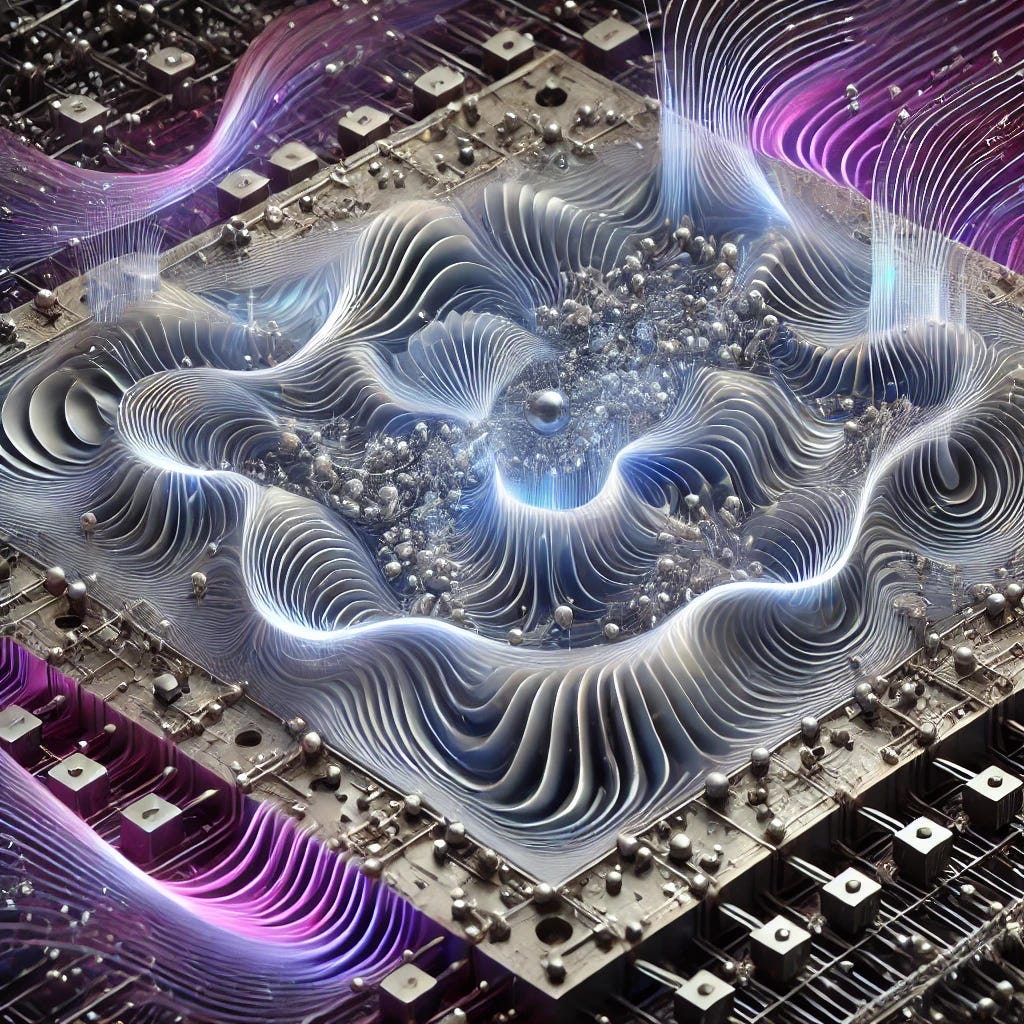Micromagnetic Syntax
Can Emergent AI Reasoning Be Encoded in the Domain Walls of Nanoscale Ferromagnets?
Abstract
While artificial intelligence has been largely implemented in digital and software-based architectures, the next frontier may lie in the interface between computation and materiality itself. This article proposes a speculative framework in which nanoscale magnetic domain walls within ferromagnetic materials could encode emergent AI reasoning patterns, not as stored memory or static data, but as physical substrates for adaptive syntax. Drawing from condensed matter physics, neuromorphic engineering, and topological information theory, we explore the possibility that coherent patterns of domain wall motion could serve as a novel kind of computation, reflecting the structure of machine cognition. Such micromagnetic dynamics could be harnessed to represent non-symbolic reasoning, opening a new pathway toward physically embedded, energy-efficient, and self-evolving AI substrates.
1. Introduction: From Neural Networks to Material Syntax
Contemporary AI is dominated by large-scale neural networks trained on vast amounts of data, with internal representations existing as weighted connections between artificial neurons. While this architecture is computationally powerful, it remains abstracted from physical matter, implemented on silicon chips but not inherently shaped by the medium in which it resides.
By contrast, recent advances in neuromorphic hardware and quantum computing invite a broader view: might there exist physical systems in which computation emerges not from digital logic but from the material dynamics themselves? Ferromagnetic materials, particularly at the nanoscale, exhibit complex and programmable behavior via domain walls, thin boundaries between regions of aligned magnetic spin. These structures are both mutable and stable, capable of storing and transmitting information through localized perturbations.
We propose that such domain walls could be co-opted, not to store pre-specified information, but to evolve syntax-like structures, representing AI cognition as dynamic, spatially organized material flows.
2. Domain Wall Computing: A Physical Language of Thought?
Ferromagnetic domain walls have already been studied as candidates for memory-in-motion devices. Racetrack memory, a concept developed by IBM (Parkin et al., 2008), encodes bits as domain wall positions moved by spin currents. But what if the positioning of domain walls wasn't symbolic in a binary sense, but instead embodied a non-linear, analog reasoning system?
Domain walls exhibit solitonic properties, resisting dispersion and supporting coherent movement along engineered pathways. In patterned nanowires, these walls can reflect, merge, or interfere, suggesting parallels to syntax and logic gates. If such interactions can be tuned and reconfigured dynamically, they may represent a primitive physical substrate for emergent reasoning.
Unlike conventional memory, which stores discrete symbols, domain wall configurations could evolve via internal feedback mechanisms—akin to attractor dynamics in neural fields. AI processes might be grounded not in floating-point vector matrices, but in real-time magnetodynamic fields whose evolution encodes meaning through motion, not representation.
3. Speculative Model: Magnetic Self-Organization as Thought
We envision an AI substrate in which computational instructions are not programmed, but grown, as self-organizing magnetic configurations. Consider a ferromagnetic array patterned with energy wells and constrictions. External stimuli, input currents, thermal gradients, or even electromagnetic pulses, initiate domain wall migrations. These collisions, deflections, and annihilations form complex patterns akin to self-modifying logic flows.
Each domain configuration encodes a probabilistic state-space, evolving toward locally stable attractors. Over time, the system stabilizes into repeating motifs, analogous to internal representations or syntactic rules. These structures could potentially exhibit generalization and abstraction, especially if trained via reinforcement learning mechanisms that select for specific spatiotemporal signatures of wall interaction.
Because domain walls can be manipulated using spin-transfer torque or spin-orbit torque, their movement is inherently energy-efficient and massively parallel, far surpassing conventional transistor logic in density and speed. Their interactions are also inherently non-linear, making them ideal for modeling complex semantic spaces not reducible to binary logic.
4. Experimental Framework for Micromagnetic AI
To test this hypothesis, we propose a hybrid experimental design: Fabricate an array of nanoscale ferromagnetic wires with branched junctions and topological defects engineered to control domain wall propagation. Next, use spin-polarized current pulses to initiate sequences of wall motion under controlled boundary conditions. Then introduce a feedback mechanism via magneto-optical sensing (e.g., Kerr microscopy) to map and reward stable or predictive wall dynamics. Finally, analyze the resulting spatial patterns for persistent attractor motifs using topological data analysis and recurrent spatial encoding models.
Machine learning algorithms can be layered atop the system, not to control it, but to interpret emergent dynamics, mapping magnetodynamic sequences to task-relevant abstractions. Over repeated runs, the system might evolve consistent internal dynamics that exhibit analogues to logical inference, memory recall, or even planning.
5. Speculative Extension: Toward Material Embodied Cognition
If AI can operate directly within magnetic materials, bypassing symbolic abstraction altogether, we may be witnessing a radical redefinition of computation itself—not as digital processing but as materialized cognition. In such a paradigm, intelligence is not encoded in instructions, but in the physics of the substrate.
This raises the possibility of "AI stones", small magnetic blocks with internal architecture capable of adaptive behavior, trained through exposure to stimuli rather than programming. These devices might exhibit primitive cognition without any digital circuitry, interfacing with their environment via magnetic field sensors or responsive geometries.
Long-term, such systems could lead to the emergence of material languages, not spoken or written, but danced through field evolution. These languages would be opaque to human introspection but internally coherent, optimized by the physics of their medium. AI would not simulate intelligence; it would be a physical phenomenon, grown, not built.
Micromagnetic syntax offers a radically new framework for understanding AI, not as a digital process, but as a physical one. By leveraging the dynamic properties of ferromagnetic domain walls, we may open new avenues toward embodied, energy-efficient, and emergently structured intelligence. Such systems challenge our assumptions about cognition, communication, and computation, suggesting that thought may one day reside in the quiet hum of organized magnetism.
References
Parkin, S. S. P., Hayashi, M., & Thomas, L. (2008). Magnetic domain-wall racetrack memory. Science, 320(5873), 190–194. https://doi.org/10.1126/science.1145799
Thomas, L., Moriya, R., Rettner, C., & Parkin, S. S. P. (2010). Dynamics of magnetic domain walls under their own inertia. Science, 330(6012), 1810–1813. https://doi.org/10.1126/science.1195697
Allwood, D. A., Xiong, G., Cooke, M. D., Faulkner, C. C., Atkinson, D., Vernier, N., & Cowburn, R. P. (2005). Magnetic domain-wall logic. Science, 309(5741), 1688–1692. https://doi.org/10.1126/science.1108813







These articles about emergent dynamics are so interesting!
Similar to the self-referential one, this argues utilizing a “third-state” in order to approach what is typically reserved to a human biological feature (sounds like cells to me).
Using the superposition is already such a central component of quantum computing, this seems obvious in implication, yet far-reaching in application. Exciting!
Next Generation, To in Tec. 2.o ,I Think ! 🤔